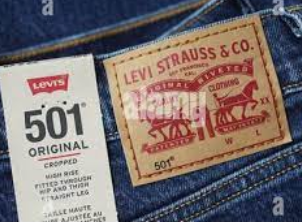Likelihood of confusion arising from intuitive assessment – Levi 501
The case: Everyone knows that in trademark development, a likelihood of confusion arising from intuitive assessment must be avoided. But could a clothing trademark consisting only of the number ‘101’ really infringe a clothing trademark consisting only of the number ‘501’?
No, thought the hunting equipment manufacturer Blaser; consequently it filed an application for registration of the brand
101
for garments as a European trademark.
However, the Californian company Levi Strauss & Co. took exception to this. It owns the prior trademark
501
and famously uses it for denim clothing:

The mark ‘101’ would be taken to be one of Levi Strauss’s marks, the company submitted. Two out of three elements in the same arrangement were the same. The two marks also designated clothing and appealed to the same customers. The similarity of marks should not be judged merely intuitively.
The EUIPO countered that customers look closely at items of clothing before buying them. A visual impression was therefore stronger than a phonetic or conceptual impression. The customer also perceives clothing marks as a whole without necessarily spelling or sounding them out or dissecting them. Since the signs in question are only short, their differences are not hidden from the customer, who would therefore immediately recognise that the mark ‘101’ consists of a symmetrical arrangement of numbers, whereas the mark ‘501’ contains an asymmetrical arrangement. The overall impression of the Blaser mark is different from the Levi’s one, and the signs are therefore not considered similar. There was no likelihood of confusion.
Was this decision correct?
Levi Strauss took the case to the General Court of the European Union.
The court first confirmed all the requirements to carry out an assessment of similarity as mentioned by the EUIPO. However, it added that the differences between the marks must be so significant that they result in a different overall impression. In this case, visually, the two signs were identical in two out of three elements in the same arrangement. In contrast, the structural differences in the symmetry of the numbers and the different numbers 1 and 5 at the beginning were too small to compensate for the similarities. There was therefore a certain degree of visual similarity. The signs were also phonetically similar because the matching part was, phonetically, significantly longer than the phonetic difference between the initial numbers. There was no conceptual similarity.
Since the consumer would rarely have the opportunity to compare the different marks side by side, they must rely on their imperfect memory of the marks. However, the consumer will be more likely to base their memory on the similarities between the signs than the differences.
In the clothing industry, it is also common for the same brand to be designed differently depending on the type of product it denotes. It is also possible for a single clothing manufacturer to distinguish its different lines through sub-brands. Such brands are derived from a main brand and share a common dominant element with it.
There was thus a risk that the consumer would see the trademark ‘101’ as a sub-brand of Levi Strauss. Because of this likelihood of confusion, the trademark ‘101’ was not registered in the European Union.
General Court of the European Union, 3 June 2015, T-604/13
Learnings: If you decide to use a new trademark, make sure that the trademark in particular cannot be regarded as a sub-brand of a prior trademark. This danger exists in particular if the similarities between the signs are more significant than the differences. To ascertain whether this is the case, you must analyse the signs carefully. The potential for the likelihood of confusion arising from intuitive assessment should be avoided.
Note: On the likelihood of confusion between trademarks, also read the following BestCase:
Likelihood of confusion for premium brand – BLACK LABEL